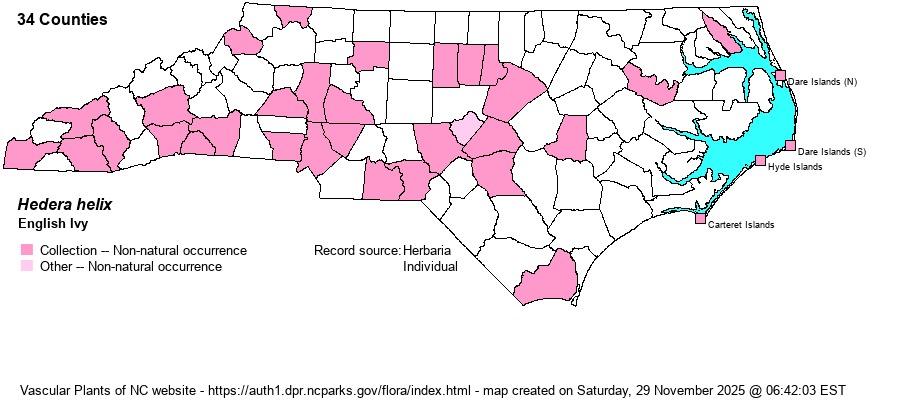| Author | L. | |
| Distribution | Mostly in the Mountains and Piedmont; scattered in the Coastal Plain and Outer Banks. First collected in 1939 on the campus of UNC Chapel Hill, Orange County (possibly not escaped then but certainly was in 1951). Certainly under-collected and expected in many more counties, perhaps in all counties as an escape or adventive.
Native of Europe; in N.A. -- N.S.; MA to WI and NE south to FL and TX; NM, AZ, Pacific states and B.C. | |
| Abundance | Uncommon to locally numerous in the Mountains, frequent to locally common in the Piedmont and Sandhills, uncommon in the Coastal Plain and Outer Banks. Has become a noxious weed locally, climbing high in trees and stressing them. Juvenile shoots spread across the forest floor and cut off light to native herbs. | |
| Habitat | Moist to mesic disturbed woodlands and forests, creeksides, riversides, ravines, swamp margin, loblolly pine forest, maritime forests, old cemeteries, vacant lots. Presence of a large patch often indicates the location of an old homesite. |
| Phenology | Flowering June-July. | |
| Identification | English Ivy has two distinct kinds of leaves: juveniles are broadly ovate and 3- (-5) lobed; and the less often seen adults are ovate, unlobed, and generally tapered to the base. Flowers occur in terminal umbels, very small, with strongly reflexed yellow petals. The plants don't usually flower on or near the ground, but well up into trees, where the adult leaves are most often found; the very familiar juvenile leaves are the ones seen trailing along the ground. All leaves tend to be evergreen, dark green, with conspicuous white veins. | |
| Taxonomic Comments | | |
| Other Common Name(s) | | |
| State Rank | SE | |
| Global Rank | GNR | |
| State Status | | |
| US Status | | |
| USACE-agcp | FACU link |
| USACE-emp | FACU link |

